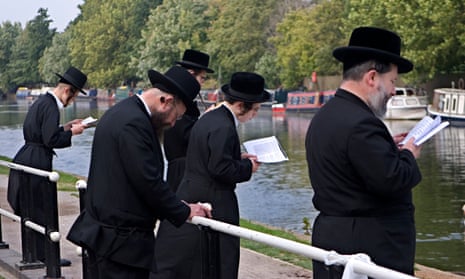As the UK’s Jewish community settles down to its Rosh Hashanah celebrations next week, many will be dipping their apples in honey in anticipation of a sweet new year. And let’s hope it is. Because, for many, this has been a time of increased anxiety with much talk of the sleeping giant of antisemitism rearing its ugly head once again. Recently, two schoolboys were refused entry to a well-known sports chain by the security guard with the words: “No Jews. No Jews.” The guard was quickly fired. But the Community Security Trust, which monitors these things, said that antisemitic incidents are up 400% on last year. And legitimate hostility to the Gaza war has given this historical racism an unfortunate alibi, even among the chattering classes.
This country has a very mixed history when it comes to the Jews. It was in Norwich, back in the 12th century, that the whole blood libel slur was invented – the idea that Jews murder little Christian children and use their blood in the making of Passover matzah. This sounds like ancient history. But, unfortunately, it is not. Earlier this month a former Jordanian MP, Sheikh Abu Zant said this on TV: “On their religious holidays, if they cannot find a Muslim to slaughter, and use drops of his blood to knead the matzahs they eat, they slaughter a Christian in order to take drops of his blood, and mix it into the matzos that they eat on that holiday.” This matzahs of wicked rubbish was dreamed up on these shores and exported to the world.
We must continue to remind ourselves of our antisemitic past. But the story that we don’t remind ourselves about often enough is our longish history of philosemitism. I say long-ish, because the explosion of pro-Jewish philosemitism was mostly a post-Reformation thing, and came especially with the translation of the Hebrew scriptures into English. Recall all those Puritans of the 17th century: why did so many of them have Hebrew names? Zechariah, Ezekiel, Daniel. Both sides in the English civil war looked back to the Hebrew scriptures for inspiration and it powerfully shaped the national consciousness. For the monarchists, the likes of David and Solomon provided a much-needed justification of kingship in the absence of the Roman church. And on the left, the revolutionary, world-turned-upside-down potential of the Old Testament became the very language of political dissent. England was seen as the new Jerusalem, the promised land. Think about it: even the unofficial national anthem of this country is named after a town in the Middle East.
It is impossible, for instance, to understand the Balfour declaration of 1917 – the British government’s game-changing support for a Jewish homeland in Palestine – without appreciating the historical background. As Lloyd George explained to the Jewish Historical Society in 1925: “It was undoubtedly inspired by natural sympathy, admiration and also by the fact that … we had been trained even more in Hebrew history than in the history of our own country.”
Of course, philosemitism is not an uncomplicated or universally positive phenomenon. Some argue that it is merely the sunny side-up cousin of its darker relative: both treating Jews as categorically different, as somehow “other”. So the historian Daniel Goldhagen dismisses philosemites as “antisemites in sheep’s clothing”. But that’s too cynical. Yes, from Cromwell’s readmission of the Jews to George Eliot’s Daniel Deronda, there was a certain degree of fantasy in the celebration of all things Jewish. But it’s a fantasy whose instincts are often benign and represent a powerful strain of anti-antisemitism. Yes, many Christians loved Jews in order to convert them – thus, they believed, to hasten the coming of the Messiah. Yes, the sleeping giant exists. But the past can be mined for the positive as well as for the negative. It is not true that the only thing that sleeps in our historical consciousness is a dormant hatred. So Shanah tovah. Happy new year.
Twitter@giles_fraser











